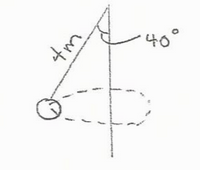
College Physics
11th Edition
ISBN: 9781305952300
Author: Raymond A. Serway, Chris Vuille
Publisher: Cengage Learning
expand_more
expand_more
format_list_bulleted
Concept explainers
Topic Video
Question
A ball is being rotated at the end of a 4-meter long string such that it is describing a circular path. If the angle that the string makes with the vertical is 40°, and the ball has a mass of 10-Kg, determine the speed of the ball and the tension in the string

Transcribed Image Text:The provided image illustrates the dynamics of a pendulum in motion. The diagram features a spherical object attached to a string, depicting a pendulum's trajectory. Key elements of the diagram are outlined and explained below:
1. **Pendulum Construction**:
- **Mass (m)**: The bob at the end of the string is circular and labeled with "m" representing its mass.
- **String Length**: The string, which is depicted as a straight line, is labeled with a length of "4m" indicating that the pendulum's string is 4 meters long.
2. **Swing Angle**:
- The string forms an angle of 40 degrees with the vertical axis when the pendulum swings to one side. This is clearly indicated by the angle notation "40°" drawn between the string and the dashed vertical line representing the equilibrium position of the pendulum.
3. **Trajectory**:
- The dashed curve around the vertical axis shows the path of the pendulum bob during its swing. This demonstrates one possible position of the mass at its extremity during a cycle and emphasizes the motion of the pendulum.
This diagram illustrates a simple pendulum's setup and the basic principles of its motion, such as its length and angle of swing. This is essential for students learning about periodic motion, gravitational influences, and harmonic oscillations.
Expert Solution
This question has been solved!
Explore an expertly crafted, step-by-step solution for a thorough understanding of key concepts.
Step by stepSolved in 2 steps with 2 images

Knowledge Booster
Learn more about
Need a deep-dive on the concept behind this application? Look no further. Learn more about this topic, physics and related others by exploring similar questions and additional content below.Similar questions
- Passengers riding in the Great Six Flags Air Racer are spun around a tall steel tower. At top speed, the planes fly at a 56-degree bank approximately 46 m from the tower. In this position, the support chains make an angle of 56 degrees with the vertical. Calculate the speed of the planes.arrow_forwardA new planet is found with a density one third as much at Earth and a radius twice that of Earth. What is the acceleration due to gravity on this new planet?arrow_forwardWhat "g-force" acts on an Air Force Thunderbird pilot (mass = 78-kg) who, at the top of a loop of radius 8.5 x 102 meters, is traveling at a speed of 320 knots? 1 knot = .5144 m/s "g-force" in this case is equivalent to the normal force acting the pilot Give your answer in Newtons to the correct significant figures (2 in this case).arrow_forward
- A person drives a car around a circular cloverleaf with a radius of 64 m at a uniform speed of 10 m/s. (a) What is the acceleration of the car? (b) Compare this answer with the acceleration due to gravity as a percentage.arrow_forwardA ball of mass 4.7 kg and a diameter of 68.2 cm is attached to a string of length 1.1 m. It moves in a circular path at constant speed, 3.0 m above the ground. The string makes a constant angle of 17 ° with respect to vertical. L m (a) What is the speed of the ball? (b) What is the tension in the string?arrow_forwardA ball of mass m is tied to one end of a string of length L, the other end of which is fixed to the ceiling. The ball is then set in motion at a constant speed in a horizontal circle of radius R less than L around the axis that the string would make if the ball were to hang at rest (the string thus makes a constant angle theta with the vertical direction). Determine how long it takes the ball to go around the circle once in terms of m, vector g, L, and theta (Comment: an object moving as described is called a conical pendulum.)arrow_forward
arrow_back_ios
arrow_forward_ios
Recommended textbooks for you
 College PhysicsPhysicsISBN:9781305952300Author:Raymond A. Serway, Chris VuillePublisher:Cengage Learning
College PhysicsPhysicsISBN:9781305952300Author:Raymond A. Serway, Chris VuillePublisher:Cengage Learning University Physics (14th Edition)PhysicsISBN:9780133969290Author:Hugh D. Young, Roger A. FreedmanPublisher:PEARSON
University Physics (14th Edition)PhysicsISBN:9780133969290Author:Hugh D. Young, Roger A. FreedmanPublisher:PEARSON Introduction To Quantum MechanicsPhysicsISBN:9781107189638Author:Griffiths, David J., Schroeter, Darrell F.Publisher:Cambridge University Press
Introduction To Quantum MechanicsPhysicsISBN:9781107189638Author:Griffiths, David J., Schroeter, Darrell F.Publisher:Cambridge University Press Physics for Scientists and EngineersPhysicsISBN:9781337553278Author:Raymond A. Serway, John W. JewettPublisher:Cengage Learning
Physics for Scientists and EngineersPhysicsISBN:9781337553278Author:Raymond A. Serway, John W. JewettPublisher:Cengage Learning Lecture- Tutorials for Introductory AstronomyPhysicsISBN:9780321820464Author:Edward E. Prather, Tim P. Slater, Jeff P. Adams, Gina BrissendenPublisher:Addison-Wesley
Lecture- Tutorials for Introductory AstronomyPhysicsISBN:9780321820464Author:Edward E. Prather, Tim P. Slater, Jeff P. Adams, Gina BrissendenPublisher:Addison-Wesley College Physics: A Strategic Approach (4th Editio...PhysicsISBN:9780134609034Author:Randall D. Knight (Professor Emeritus), Brian Jones, Stuart FieldPublisher:PEARSON
College Physics: A Strategic Approach (4th Editio...PhysicsISBN:9780134609034Author:Randall D. Knight (Professor Emeritus), Brian Jones, Stuart FieldPublisher:PEARSON

College Physics
Physics
ISBN:9781305952300
Author:Raymond A. Serway, Chris Vuille
Publisher:Cengage Learning

University Physics (14th Edition)
Physics
ISBN:9780133969290
Author:Hugh D. Young, Roger A. Freedman
Publisher:PEARSON

Introduction To Quantum Mechanics
Physics
ISBN:9781107189638
Author:Griffiths, David J., Schroeter, Darrell F.
Publisher:Cambridge University Press

Physics for Scientists and Engineers
Physics
ISBN:9781337553278
Author:Raymond A. Serway, John W. Jewett
Publisher:Cengage Learning

Lecture- Tutorials for Introductory Astronomy
Physics
ISBN:9780321820464
Author:Edward E. Prather, Tim P. Slater, Jeff P. Adams, Gina Brissenden
Publisher:Addison-Wesley

College Physics: A Strategic Approach (4th Editio...
Physics
ISBN:9780134609034
Author:Randall D. Knight (Professor Emeritus), Brian Jones, Stuart Field
Publisher:PEARSON